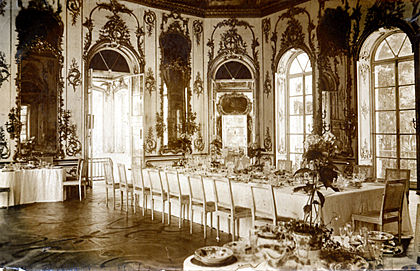
This room was a real jumble of furniture in different styles. Pillows have been added to make the furniture more comfortable and perhaps to give the room a more cosy feeling. The cornices pediments and modeling are all made of molded plaster and the walls are covered in damask. On the walls are paintings in the style of the famous Russian painter Aivazovsky, who had been a big hit in his own country and abroad. The artist specialized in giant seascapes. A huge and highly acclaimed exhibit of the artist's work was organized in Philadelphia in the 1870's, with the artist travelling all the way to America be at the opening. Behind the sofa, in the right-hand corner - can be seen a huge neoclassical urn - probably a manufacture of the Russian Imperial Porcelain Factory. Through the door can been since the corner of the drawing room shown in the previous page.
The Salon of the American Embassy would have been a place for entertaining. The Ambassador was responsible to pay for the costs of his own entertaining receptions and he was hard pressed to do more than one reception and one official ball a year.
Organizing an event would be very time consuming and tedious. Everything from food and flowers to wine and music had to be arranged for a very exacting audience. Delivery of beautiful engraved invitations was done by messenger - using the mail for invitations to gala events was considered bad taste. Food could be bought rather inexpensively, but good cooks trained in the French style could be very expensive. Hosts had the option of employing the chefs of famous Petersburg restaurants to organize their food service. Fresh cuts of meat were easy to find - particularly in winter. Being near the sea St. Petersburg was well supplied with many kinds of fish and seafood. Sophisticated epicures in 1900 expected fine fruit to be served with their meal and this could be very expensive if grown in hothouses or brought in from abroad. Occupying a rented house it's probable the US Ambassador didn't have access to an official embassy wine cellar. This meant the Ambassador would have to bring in a wine merchant to provide his party with the selection his guests would expect - hopefully at a reasonable price.  Above: A Pavilion at the Catherine Palace, set for a gala meal.
Merchants could also be enlisted to come in and make the floral arrangements. It was possible to rent silver and china if the embassy was unable to supply enough from its' own stocks. Some Embassies, such as the British, served off of old incredible heirloom silver and porcelain (possibly the best silver collection in Russia after the Tsar's was the British Embassy collection). It was difficult for smaller embassies - like the American - to compete with the gala affairs thrown by France and Austria and this was a constant embarrassment to US Ambassador and his small staff.
Next photograph: The Hotel Europe
For a small map of the St. Petersburg area click here.
To see a large map of the center
of St. Petersburg go here.
Comments on the website should be sent to Bob
Atchison. | 
